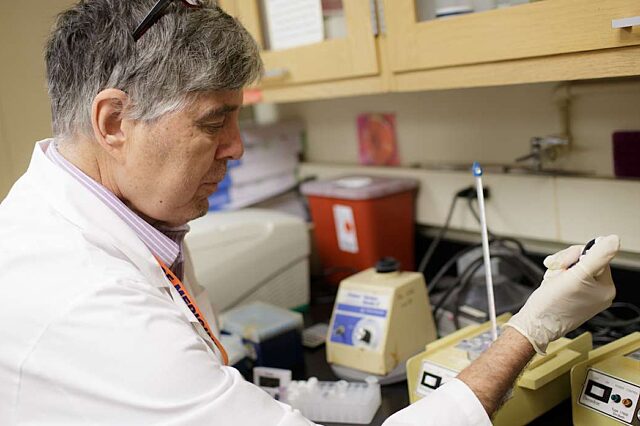Study: Immune system markers may be key for early detection, prognosis prediction in sepsis

With a focus on innovation, collaboration and academic excellence, the Sepsis and Critical Illness Research Center aims to develop clinical solutions for sepsis, as well as related illnesses and enduring effects.
Sepsis arrives silently.
A body’s infection-response gone wrong, the condition’s early symptoms include subtle harbingers like changes in breathing, cognition and shivering. Without intervention, this can rapidly progress to septic shock and multiorgan failure, which are often fatal.
Now, new research from a consortium of seven major university medical centers led by the University of Florida has identified a way to predict as early as the fourth day of admission whether a septic patient is at an increased risk of dying.
Typically, clinical outcome predictions for sepsis patients have relied on using blood proteins or DNA biomarkers. But in the study, published in JCI Insight, researchers at UF, Universities of Washington, Minnesota, Iowa, Cincinnati and Case Western, and Washington University medical centers are shifting to measuring functional immune responsiveness for a precise, early warning sign.
“Past success in the application of new therapeutics to the treatment of the sepsis has been dismal,” said Lyle L. Moldawer, Ph.D., a professor and director emeritus for the UF Sepsis and Critical Illness Research Center. “This is due in large part to the heterogeneity in the severity of sepsis when the patients present and the different immunological endotypes they present with.”
According to the study, measuring immune function using ELISpot analysis, a technique that detects the quantity of specific secreted proteins by individual immune cells, can be used to identify sepsis patients at increased risk of mortality — and even let clinicians know when their immunological defect is one that is immune suppressive, Moldawer pointed out.
Most studies examining the ability of clinicians to predict patient prognoses in the sepsis field have relied on either the analysis of large, retrospective databases or have been conducted in real-time at single institutions, he said. The current study, by contrast, leverages a robust multicenter format and demonstrates the benefit of a particular functional diagnostic as not only a means of determining patient prognosis in the future, but also an endotyping tool.
“Immune suppression during sepsis has long been associated with secondary infections and mortality. The functional assay developed here will allow the attending physician to actually monitor the patient’s immune suppression during the patient’s stay,” said Charles C. Caldwell, Ph.D., co-PI on the study and a professor in the University of Cincinnati’s Department of Surgery.
“Taken together, these studies clearly identify a cohort of sepsis patients at risk of dying from sepsis and a potential therapeutic approach to their treatment,” he said. The team was able to demonstrate the superiority of a functional prognostic over traditional protein and cell type metrics to identify at-risk sepsis patients, he added, and to target personalized therapeutic approaches.
The study is but one component of the Sepsis and Critical Illness Center’s ongoing efforts to better describe and understand the different immunological pathways behind sepsis that could benefit from targeted, personalized therapeutics.
Next steps may include using this test in clinical studies that seek to reverse immune suppression, as this would allow scientists to identify the population most likely to respond to this kind of immune modulator. For now, researchers believe this is a step toward being able to provide ever-improving, tailored care to each patient.
“Continued studies funded by the NIH are underway to make findings like these more actionable to clinicians involved in the care of sepsis patients, to shorten the turnaround time from blood sampling to result, and to identify specific therapeutics that would be appropriate interventions,” Moldawer said. “We’re excited to see what’s next.”